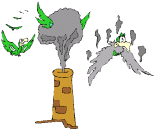
Wildlife

Animals are exposed to air pollutants via the inhalation of gases or small particles and the absorption of gases through the skin. In general, only soft-bodied invertebrates (e.g. earthworms), or animals with thin, moist skin (e.g. amphibians) are affected by the absorption of air pollutants. An individual's response to a pollutant varies greatly and depends on the type of pollutant involved, the duration and time of exposure, and the amount taken up by the animal. The individual's age, sex, health, and reproductive condition also play a role in its response.
Volatile organic compounds and nitrogen oxides, emitted from road transport and industrial processes, undergo chemical transformation in the atmosphere in the presence of sunlight to form ozone. Ozone, sulphur dioxide, and nitrogen dioxide primarily affect the respiratory systems of animals. Birds may be even more susceptible to gaseous pollutant injury than mammals due to their higher respiratory rates.
Poor air quality can also affect vegetation. Sulphur dioxide, one of the main components of acid rain, has direct effects on vegetation. Changes in the physical appearance of vegetation are an indication that the ability of many plants to photosynthesise (generate food from sunlight, water and carbon dioxide) is impaired by the concentration of sulphur dioxide. Harm caused by sulphur dioxide is first noticeable on the leaves of the plants. For some plants injury can occur within hours or days of being exposed to high levels of sulphur dioxide. Leaves in mid-growth are the most vulnerable, while the older and younger leaves are more resistant. Damage to coniferous needles can be seen in the extreme colour difference between the green base and the bright orange-red tips.
The effects of sulphur dioxide, however, are influenced by other biological and environmental factors such as plant type, age, sunlight levels, temperature, humidity and the presence of other pollutants (ozone and nitrogen oxides). Thus, even though sulphur dioxide levels may be extremely high, the levels may not affect vegetation because of the surrounding environmental conditions. It is also possible that the plants and soils may temporarily store pollutants. By storing the pollutants they are preventing the pollutants from reacting with other substances in the plants or soil.
The biochemical mechanisms by which ozone interacts with plants have been intensively studied. There is a consensus that the key event in plant responses is oxidative damage to cell membranes. This primary oxidative damage to cell membranes results in the inhibition of essential biochemical and physiological processes, including photosynthesis. These changes result in reduced growth in many plants, although this varies from plant to plant and species to species. Ozone may also increase the severity of many fungal diseases.
Websites
Other topics
• US Wildlife Federation
• US Park Service
• US Park Service
• Ozone on Plants
• Introduction
• Asthma
• Carbon Monoxide
• Cars
• CATs
• Chemistry
• Cities
• Clean Air Acts
• Cleaner Fuels
• Countryside
• Dispersion
• Doing Our Bit
• Dustmite
• Emissions
• Fossil Fuels
• History
• Human Health
• Impacts
• Indoors
• Industry & Power
• Legislation
• Lichens
• London Smog
• Management
• Measuring
• Megacities
• Modelling
• Monitoring
• Mould Spores
• Natural Sources
• Nitrogen Dioxide
• Outdoors
• Ozone
• Particulates
• Pollutants
• Radon
• Smog
• Smoke
• Smoking
• Standards
• Sulphur Dioxide
• UK Air Pollution
• UK Strategy
• Vehicle Controls
• VOCs
• Wildlife
 Print Topic
Print Topic